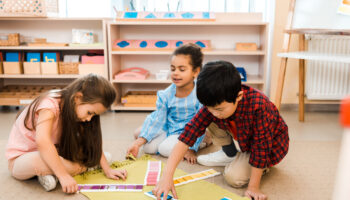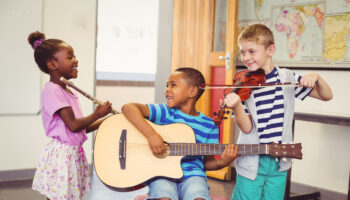Natalie Grebe
Imagine walking into a classroom and observing the children moving seamlessly from one activity to the next. No temper tantrums, no challenging behaviors. It’s as if the children practiced how they were going to behave before you arrived. This teacher is good, you’d think. You would bet she has a group of easy going, rule followers, right? Perhaps what you’re observing is a classroom where the transitions have been well thought out and implemented in a way that works for the teacher and the children.
Whether you’re a novice teacher or a seasoned one, you probably know by now that children don’t always want to stop one activity and move on to the next one. In fact, it’s quite a feat to have a group of young ones switch from one activity to the next without any hiccups. Depending on the day or whether there’s a full moon outside, transitions could be the least favorite part of your day. So how do you make this work for you and the children in your classroom you’re wondering? Keep calm and read on.
In order to have the smooth and efficient transitions one dreams of, be prepared to do some prep work behind the scenes, so to speak. Keep calm and observe. Watch what happens when you signal to switch activities. Analyze how the children respond and identify the ones that have a difficult time stopping the activity. Time how long it takes from start to finish.
After observing your transitions, begin to reconstruct them. Start from the beginning and plan transitions into your day. Decide if the children in your care would benefit from having verbal cues before the transition will take place. For instance, “When the long hand on the clock reaches the 12, it will be time to clean up.” When it is finally time to make the transition, include verbal and/ or nonverbal cues. “1, 2, 3, eyes on me,” could be your signal that tells the children to stop and listen for what comes next. Maybe it’s the ringing of a bell or a familiar song that works too. Having a picture schedule posted in the classroom helps to follow a predictable schedule. After finding what works for you and your children, keep calm and stick to the routine.
Transitions that are predictable for the children allow them to know what is coming. Develop a transition that can become part of their everyday routine. For instance, when it is time to switch activities, cue the children with a clapping pattern for them to copy. This cue signals for them to stop and listen for the next direction. When all eyes are on you, give a simple direction, such as, “When I say go, it is time to put away the toys and sit on the carpet quietly.” Clear, efficient and direct. From here, model and practice this strategy as you would other routines. Keep calm and practice, practice, practice.
Design your transitions to minimize long waits. Oftentimes, transitions waste valuable time if not planned effectively. This, in turn, can cause challenging behaviors to occur. To help create positive interactions, offer individualized teaching for a child who has difficulty with transitions. For instance, before giving the class signal, offer an individual cue to the child beforehand. If you know that “Johnny” has a difficult time transitioning from the playground to the classroom, find a solution to the issue. Perhaps showing “Johnny” a picture board with what happens first, next, and last will make transitioning smoother.
The key is to keep the youngsters engaged during transitions, especially when there is wait-time involved. We all know how it can turn out when children have to wait in line to wash hands after outdoor play if they have nothing to keep them occupied. These are the times we need to actively engage the little ones to keep them on their best behavior. If not, look out! Challenging behaviors may arise. Instead, sing a movement song like Head, Shoulders, Knees and Toes, or clap a pattern they need to echo. Play I Spy or have some easy exercises they can do. It’s always entertaining to watch little ones do jumping jacks. If you have your children read books during transitions, ensure they are engaged. If you notice a child isn’t looking through the book or reading it, perhaps you could prompt him/her by talking about the cover of the book or the title. This could jump start their curiosity. Keep calm and keep them engaged.
After implementing transitions, take time to reflect and modify accordingly. Perhaps you’ll find you need to make some changes where you see fit. Knowing the needs of the children you teach can make all the difference. When you find what works for them, you find the way to keep calm and transition on.
Center on the Social Emotional Foundations for Early Learning
Ten Tips to Deal With Those Troubling Transitions
Transition Movement Into the Curriculum




